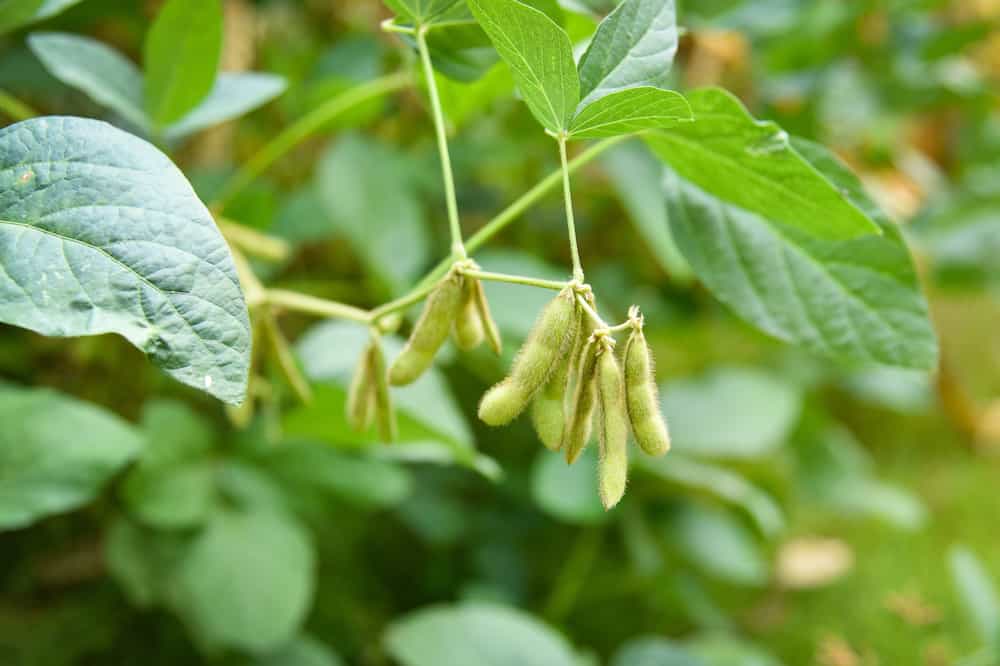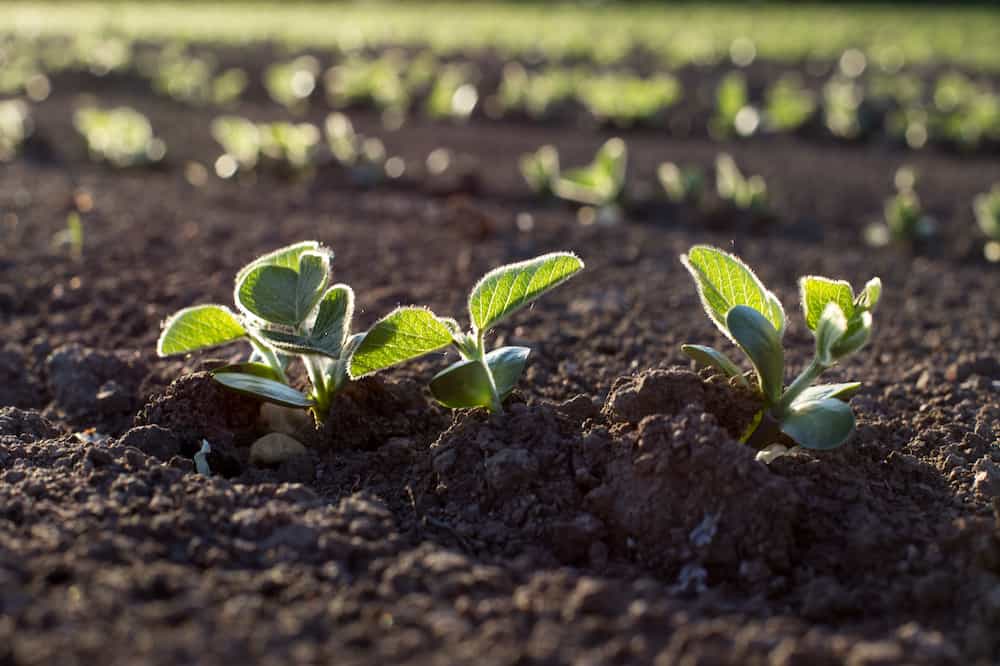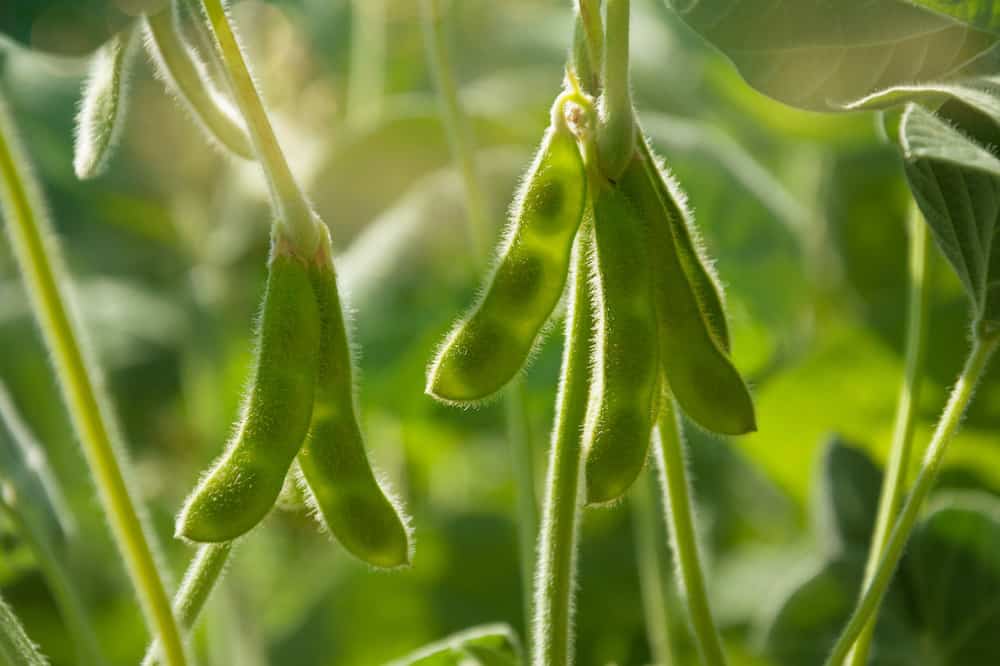Soybean plants grow soybeans, which are legumes. They are easy to grow in warm season months. The beans take approximately 80 days to harvest.
Soybeans are an annual crop, popular in the midwestern United States.
Soybean Plant
A soybean, despite the name, is not a bean at all and is classified as a legume. It’s scientific name is Glycine max. The soybean plant is native to East Asia.
Soy is the same as soya. Soybeans are also called soya bean or soya. Soybeans are made into several different types of foods. You can find soybeans, also called edamame, in the frozen section at the grocery. Edamame is an immature soybean.
What Does a Soybean Plant Look Like?
Soybean plants are bushels of green leaves with stems that have soybean shells attached to them. They grow 3 – 5 feet tall.
The shell is what holds the legumes, which are what you eat. It protects them from the elements and feeds them while they’re growing. These shells are often found in large groupings, but the individual shells typically hold three or four legumes.
You can see the number from the exterior because the shell dips in between each legume. The result is a wavy-like shell that resembles a pea pod. Soybean plants have flowers which self-fertilize.

How to Grow a Soybean Plant
There is quite a bit to learn about growing soybeans. Whether you want to have a few soybean plants in your garden or a field of them, here’s how to do it.
Right Conditions
If you live in climate hardiness zones 2 – 11, you can have a successful crop production.
You must plant them at the right time to ensure soybean germination and a successful growth rate and yield. Ideally, soil temperature should be around 50 degrees. Depending on your hardiness zone, this is generally in late spring, early summer.
Early planting might be able to boost your soybean yields, but it depends on the temperature.
Plant Soybeans at Right Depth
You will also need to consider the depth at which you plant the seeds in the ground. Depending on where you live, when you plant them, and the temperature, this depth with vary between 1 – 2 inches deep.
According to Michigan State University, you should plant closer to 1″ in depth:
- Early in the season
- Moist soil
- Fine-textured soil
- Areas with high crop residue
Plant deeper, to 1.5″ when:
- Planting soybeans later in the season
- In dry soil
- In coarse-textured soil
- Large seeds in soil that crusts
Plant soybeans 2″ when:
- Planting in sandy soil
- Larger seeds if soil doesn’t crust
If you plant soybean too deep, they will take longer to emerge. Soybeans are sensitive to planting depth.
There was a university study who measured how many plants grew from different numbers of seeds per acre. It determined planting 140,000 seeds per acre yielded 100,000 plants. To use this seeds per acre rule in a small garden, you can estimate 70 percent of your seeds will sprout.
While growing them in your backyard won’t yield bushels per acre, you will enjoy a lot of pods. Most plants will yield 50 -100 pods. Plants can have up to 20 nodes.
How Often Should I Water My Vegetable Garden
Get High-Quality Seeds
Be sure to choose high-quality soybean seeds. There are a variety to choose from. Choose organic soybean seeds from a hardware store or garden center or order from a seed store. Be aware of buying them online unless they are from a direct supplier.
If you want to make a good yield, you will need to invest in quality seeds for a better harvest.
Quality Soil
Soil moisture is essential to germinate soybeans. They’ll grow best well-draining and loose types of soil. The pH level for soil should be between 6 – 6.8.
Amending soil with compost and organic matter will give soybean seeds and roots the nutrients to feed them. Soybeans do not grow well in a garden with poor soil.
Soil treatments can be an expense that you don’t feel like you need, but without them, it can lead to many problems down the line. Investing in decent soil treatments can help you a lot. Also, they tend to have a very high return for your investment. Getting the best of the best will help you keep your seeds healthy and able to harvest.
Sun
Plant soybeans in full sun. The soybean plant is not frost tolerant. It’s a warm season crop.
Companion Plant to Soybean
You can plant buckwheat with soybean plants.
Weeding
Weeds can be a big issue when they start popping up around your soybean fields. Staying on top of this issue from the start will keep it at bay. Controlling weeds without fertilizers is ideal. Pull them when you see them.
Should you grow in pots and planters, you may have less weeds.
Pests
Inspect them every few days when watering. Bean leaf beetle infestations are common in many areas.
Add Potassium
As soil dries, potassium levels decline. When you are maintaining your soil, adding potassium could be very helpful. Having a higher level of potassium will help your soybeans do better to survive droughts. If you are a backyard gardener and can water them yourself, it may be unnecessary to add potassium.
Choosing a fertilizer with potassium is an easy way to enrich the soil.
Spacing Soybean Plants
When growing soybeans in smaller area such as a garden or garden bed plant seeds a minimum of 5″ apart. This means, all around the plant, there should be a clearance of 5″.
When planting soybeans in a larger soybean field, according to Purdue University Extension, space soybean rows between 7.5″ – 15″ apart.
You may opt to thin the soybean plants as well. Spacing is important to ensure plants get enough nutrients.

How Long Do Soybeans Take to Grow?
If you want to grow your own soybeans, knowing how long they take to grow will give you an idea of when you can start your harvest.
The time it takes for the soybeans to sprout and produce leaves and pods will depend on certain factors, but the most important one is temperature.
If the soil is colder, it could take up to about four weeks. That is because the sprout must grow through the tougher soil. This is harder to do when the ground above them is cold and compacted.
On the contrary, if the soil is warm enough for them to grow through at a steady pace, it will take about two days to germinate and grow up from the ground.
Rot is common if there are heavy rains or if you overwater.
The longer your soybeans stay in the ground, the higher risk they have of getting a disease. Soil-born illnesses could kill or damage your plants before they even grow. This could affect your harvest greatly. Having some type of protectant or treatment for the soil can help defend against this.
Where Do Soybeans Grow Best?
Soybeans grow best when they are in a warm climate that doesn’t get too cold. Areas where hard frost is not likely, will make a good choice for them to grow.
Regions like the southern parts of Canada and the USA’s Midwest areas are some of the best options for soybean production. In the United States, they grow well in hardiness zones 2 through 11.
However, they are also popular in tropical areas like in Indonesia, where the warmer weather will keep the ground from getting too cold.
These regions have the perfect blend of warm and cooler weather suited for soybeans fields and successful growth.
As a home gardener, you can also grow soybeans in greenhouses where you can better control the conditions indoors. They will allow you to keep the soil at a certain temperature so that the soybeans can grow well even in a region where the average temperature would be too cold for them to survive.
What Is Soybean Used For?
The small bean inside the shell has many uses that make it very versatile. Soybeans are used in the production of vegetarian foods, soy milk, tofu, and fermented foods such as soy sauce.
These edibles tend to be lower in fat and high in protein, making them a healthy option. With a rise in plant-based diets, there has been a recent push for more soy-based products. That said, you can also use soybeans for non-edible purposes.
According to the USDA, processed soybeans are the world’s largest source of animal protein feed. In addition, soybeans account for approximately 90% of the US’s oilseed production. These legumes are sometimes used to make fuel as an alternative to petroleum. The United States produces more soybean crops than any other country.
Here are some of the most common and popular uses of soybeans.
Consumption
Soybeans are popular because of their ability to provide protein and oils. They can be made into soymilk and other lactose-free and milk-free alternatives like soymilk coffee creamers or eggnog.
It can also be used in making soy meal, which is often used to feed farm animals on a larger scale.
Tofu and Tofu Skin
Tofu is another huge staple that comes from the soybean. It is used in many Asian dishes and is becoming more popular in other areas of the world.
You can often find tofu cooked with vegetables and poured over rice, or used in some soups. There are also vegan options where tofu is made into plant-based meat alternatives for luncheon meat and other animal products.
Fermented Food Creation
Fermented foods made of soybean can also be found. These include bean paste, soy sauce, and tempeh.
Fertilizer
Some experts also claim that soybeans could be an option for fertilizers, but this still needs to be studied more to have a definitive answer.
Biofuel
As an alternate fuel source, soybeans can be used as a source of energy to fuel diesel engines.
Soybean Growth
Soybeans are a popular food option. Soybean plants are suited to many climates, making them easy to grow. They are a wonderful addition to your harvest to table meal.
Keep in mind, though, that the plant and your soybeans fields require some maintenance. As such, if you want to grow these legumes on your own, follow the tips and tricks we provided to ensure you make it well worth your while. Growing them in the correct hardiness zone is the way to start being successful growing soybeans.
Consider also growing pole beans for a summer harvest.

